- Peperomia Serpens: How Easy It Is To Care For It? - September 24, 2021
- Best Indoor Fiberglass Planters Guide: Our Top Picks - September 6, 2021
- Peperomia Polybotrya: Is It Easy To Keep This Plant Alive? - August 31, 2021
Some people like collecting succulents. They plant different kinds of these water-storing plants because, quite frankly, it’s quite easy to grow these plants once you learn how. Another reason is that succulents vary from one another when it comes to looks. Some are small like lithops; others grow in rosettes, while others are spherical.
Then there is the Euphorbia Trigona or the African milk tree. Despite the name, this plant is succulent. And the good news is that it’s very easy to grow this in your garden or as a houseplant. What are the things that you need to know about growing a Euphorbia Trigona? Why find a comfy chair and read on to discover why you should have this plant in your living room or garden.
How to Identify Euphorbia Trigona
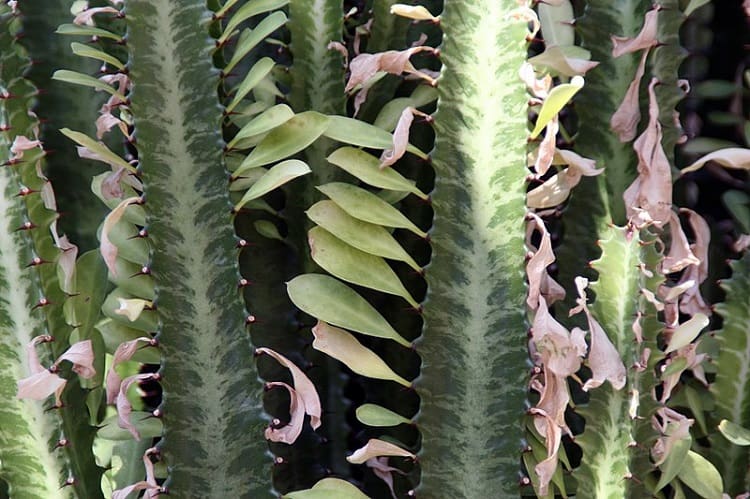
The Euphorbia Trigona has one upright stem. This stem has several branches that also go upward, giving the plant a candelabra look. Euphorbia Trigona may be easy to identify. When they grow in the wild or your garden, they can be tall as trees, often reaching more than eight feet (two to three meters) tall.
The leaves grow along the edge of the stems, which like in most cacti and succulents, are green. They also have thorns that grow in pairs, with a leaf in the center. While this plant looks like a cactus, it does have one key difference: the white sap. Most cacti have clear or transparent sap. The Euphorbia Trigona’s juice is white and can be toxic.
It can irritate one’s eyes and skin, and it may even cause some gastrointestinal problems when eaten.
Where Does Euphorbia Trigona Grow
Euphorbia Trigona is a native of Central Africa, so it’s used in arid climates. In the United States, it can live and thrive in USDA Hardiness Zones 9b to 11, which means that it can be planted anywhere with temperatures that range from 25 to 50 degrees Fahrenheit (-3.9 to 10 degrees Celsius).
However, if you live in areas that have cold winters, you will need to bring the plant inside or overwinter it. It can do quite well in Arkansas, Arizona, Hawaii, Puerto Rico, California, and Texas, among other states in the zone.
Uses of Euphorbia Trigona
Euphorbia Trigona is often sold as ornamental plants and houseplants. They can give your garden or yard a contrast point with its height and form. Because of the thorns, you can also use Euphorbia trigona as a fence plant or a privacy hedge. In other countries, these plants are planted for both ritual and medicinal purposes.
The sap of this plant can be mixed with palm wine. The concoction is drunk to ease severe constipation or epileptic seizures. The latex is also used as arrow poison, fishing, and criminal poison.
How to Grow Euphorbia Trigona from Seed
You can grow Euphorbia Trigona from seeds, which will take around 10 to 15 days to germinate. You will need a moist growing medium to help them along. Once they germinate, sow them in well-draining soil at around a quarter of an inch (six millimeters) deep.
The thing is, it may not be that easy to germinate Euphorbia Trigona seeds even with the best conditions. The process can also be very slow, even if you do succeed in germinating them. But the biggest obstacle to planting these plants from seeds is that it’s very difficult to find them.
Euphorbia Trigona Growing Conditions
Euphorbia Trigona can live in mildly alkaline to mildly acidic soil, with a pH of 6.1 to 7.8. So you can plant it in whatever soil you have, and the plant will tolerate it. However, while Euphorbia Trigona isn’t very particular with the type of soil you put it in, it is a succulent that likes a well-draining growing medium.
Sandy or sandy loam might be ideal. If you have heavy clay soil, augment it with gypsum, composted leaves, organic compost, or pine bark to make it better draining. This video will show you how to improve clay soil with materials that you have available:
Propagating Your Euphorbia Trigona
A better way to have more Euphorbia Trigona is to propagate by cuttings. Choose a healthy stem that doesn’t have blemishes.
The best cuttings are around five to seven inches (17.8 centimeters) in length. Be sure to first sterilize your knife or blade before you cut the stem. Once you’ve removed the stem from the mother plant, set it aside and let it callus for a few days. Put perlite in a pot and then bury the cutting around two to three inches (5.1 to 7.6 centimeters) deep.
Be sure that the cutting won’t fall over. You can prop it up with a coarse rock for support. Then move the cutting to a moderately lit area that is quite warm.
When to Plant Euphorbia Trigona
Whether you’re growing Euphorbia Trigona from seeds or cuttings, the best time to plant or propagate them is during the spring, right through summer. Temperatures should be around 70 to 75 degrees Fahrenheit (21 to 24 degrees Celsius).
The hottest days of the year will help encourage the seeds to germinate and the cuttings to root.
How to Plant Euphorbia Trigona
When planting Euphorbia Trigona, it will help to know the conditions that it likes. Being succulent, it will do best in a bright area with just enough water to moisten its well-draining soil.
Euphorbia Trigona Water Requirements
Despite the name African milk tree, this plant is succulent. It doesn’t require too much water, and you are probably better off neglecting it and letting go a bit drier than overwatering it.
When grown outdoors, you can get away with letting Mother Nature do the watering for you. Normal rainfall will give your Euphorbia Trigona all the water it needs to grow healthy. But if it’s an especially dry season, you might want to give your plant a bit of watering near the roots.
When grown indoors, it’s best to schedule a weekly watering or when the soil becomes dry to the touch. This video will teach you one good way to water succulents, and that includes the Euphorbia trigona:
Euphorbia Trigona Sun Requirements
Euphorbia Trigona might look like a cactus, so some people mistakenly put them under full sunlight. But this plant actually likes to be in partial shade for as long as it still gets bright light. Putting it under the intense heat of the sun may scorch the plant. Indoors, you might want to place a Euphorbia Trigona next to a south-facing window where it could get all the light that it needs.
Best Euphorbia Trigona Fertilizer
You will need to feed your African milk tree while it’s actively growing. Liquid fertilizer is best to help it be healthier and grow better. Check out these products:
- MicroLife Cactus & Succulent: With an NPK ratio of 3-7-3, this fertilizer has more than 100 vitamins, natural stimulators, and minerals to keep your Euphorbia Trigona healthy.
- Cute Farms Succulent, Cacti, & Aloe Fertilizer: This fertilizer is easy to apply and gentle enough for monthly use.
- Easy Peasy Succulent Plant Food: Gives your Euphorbia Trigona all the nutrients it needs to be healthy and thrive
- Aquatic Arts Succulent Fertilizer: May encourage healthy growth with a 3-1-2 NPK ratio.
Best Euphorbia Trigona Companion Plantings
The best companion plants for Euphorbia Trigona are those that have the same care requirements: well-draining soil, just enough water, and some fertilizer while it’s actively growing.
Flapjacks
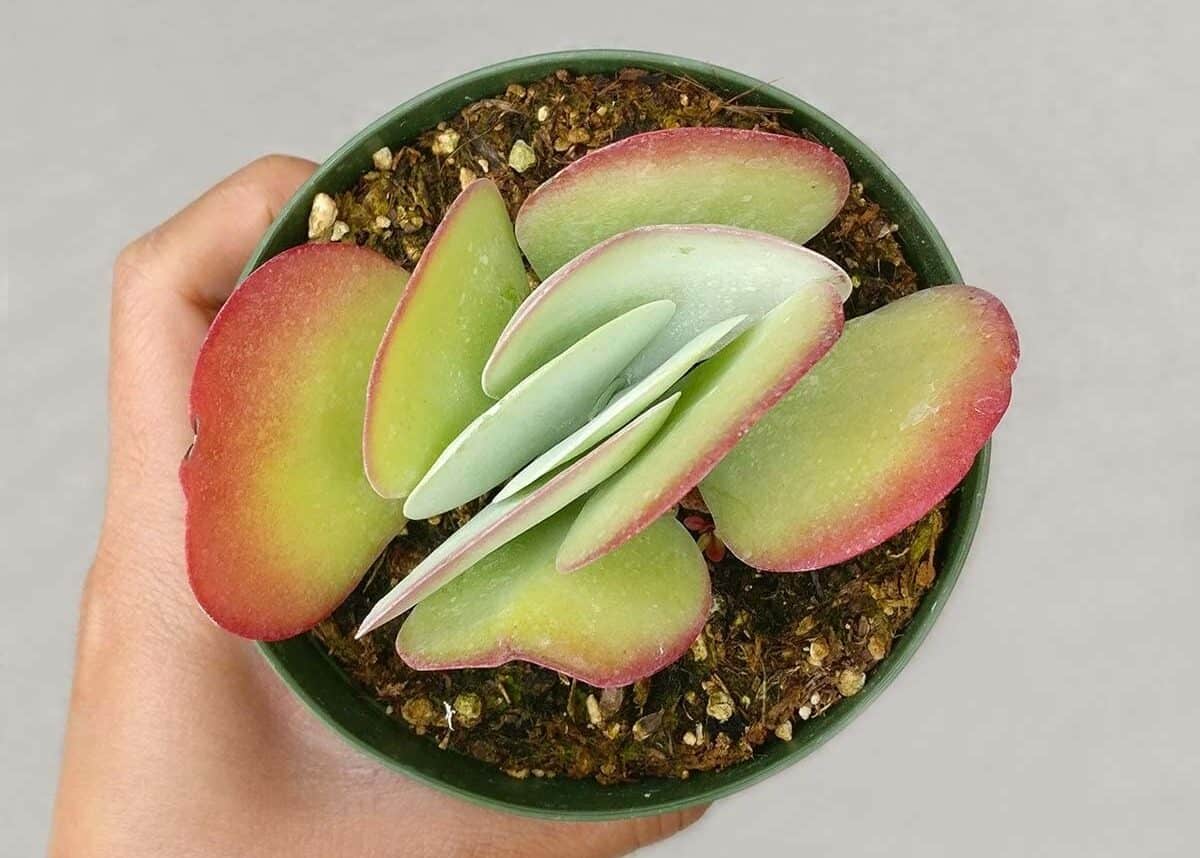
Kalanchoe Thyrsiflora ‘Flapjacks’ is a succulent that can reach 18 to 24 inches (45.7 to 61 centimeters) when fully grown. These plants live thrive in partial to full sun and are drought tolerant. As it needs very little water, these can surround your Euphorbia Trigona. The white frosted leaves with red margins will help break the all-green feature of your Euphorbia Trigona.
Firesticks Pencil Plant
Euphorbia tirucalli ‘Firesticks’ should give an interesting change of form and shapes when planted along your Euphorbia Trigona. Usually grown in containers, firesticks look like pencils. These plants have red stems that can sometimes become pink, yellow, or orange. In containers, they grow up to four to six feet (1.2 to 1.8 meters).
Jade Plant
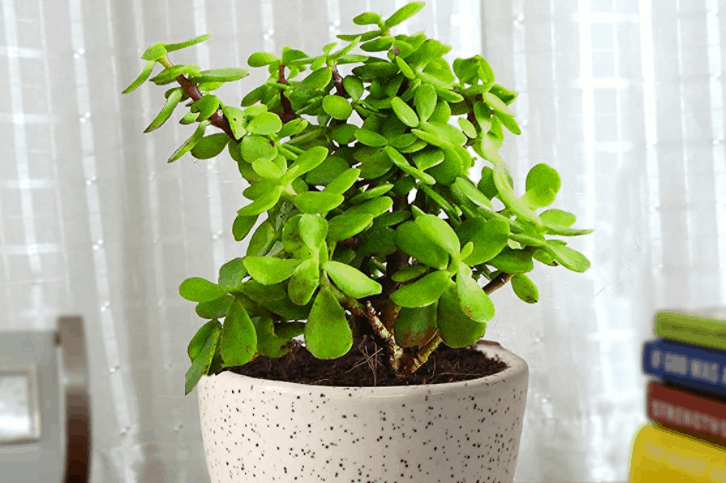
Green on green never hurts. So how about letting a Crassula ovata party with your Euphorbia Trigona? A jade plant has smooth, shiny, and round leaves that can grow quite thick. The dark green foliage is a good contrast to the green/pale green colors of your Euphorbia.
The jade plant may also give you small pink or white blooms when you treat it right.
Desert Rose
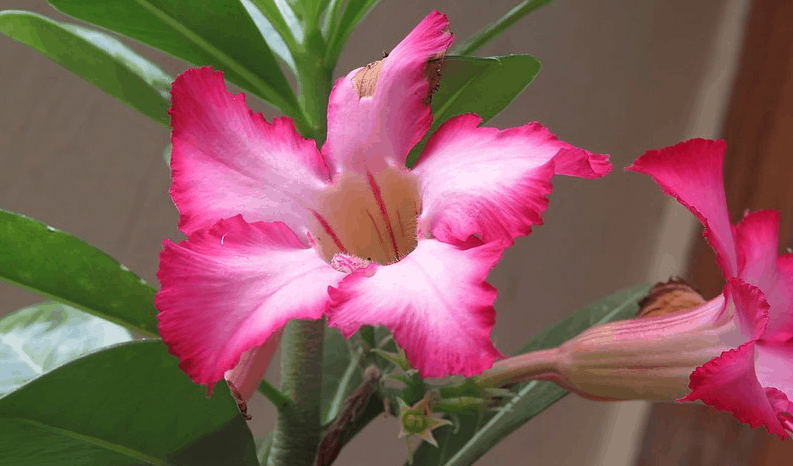
Because the African milk tree grows tall and green, you can plant an Adenium obesum near it. These plants grow up to 24 to 36 inches (61 to 91 centimeters) in containers, complementing the taller Euphorbia Trigona. What’s more, a desert rose has blooms that can easily give a stark contrast to the greens of a Euphorbia Trigona.
Euphorbia Trigona Diseases and Common Problems
The thing with the African milk tree is that it’s very hardy and resistant to pests as long as it’s well-cared for and healthy. But sometimes, they can be susceptible to spider mites and mealybugs.
Mealy Bugs
Mealybugs are insects that plague a lot of plants, not just your Euphorbia Trigona. They can be very small with oval bodies and waxy filaments. Mealybugs can suck the juices of your plants, which in turn makes them wilt, discolor, or curl. They also leave honeydew, which invites another pest to your plants: ants and black sooty mold.
Use an insecticide to get rid of mealy bugs if the infestation is too massive. Otherwise, you can just use a paper towel that’s soaked in rubbing alcohol. Some products you can use to control mealybugs include:
- Vaxxen Labs Isopropyl Alcohol 99%
- Ortho MAX Malathion Insect Spray Concentrate
- Trifecta Crop Control
Scale
Scale insects can infect your Euphorbia Trigona, and these tiny insects can damage your plants. Unlike mealy bugs, these scale insects might have armor that makes them more difficult to get rid of. You can pry them off the plant using your fingernail or a credit card.
But if not, you can use rubbing alcohol, soapy water, or insecticides to do the trick. Another remedy you can try is neem oil, like the Pure PetraTools Neem Oil.
Stem and Root Rot
More than insects and pests, too much moisture is more likely to kill your Euphorbia Trigona. Humid conditions may cause your plant to develop stem rot.
Meanwhile, if it sits in soil that’s too moist for a long time, the plant may get root rot. So be extra careful when watering.
Euphorbia Trigona Treatments and Maintenance
Aside from the treatments for pests that we have outlined above, you might also want to prune your Euphorbia Trigona. Strictly speaking, you might get away with not pruning this plant all your life, but you might want to cut back if you think that it’s getting too heavy for its roots.
The good news is that it doesn’t go to waste if you do prune the African milk tree. You can propagate it for more Euphorbia Trigona plants that you can plant in your yards or give away to friends.
Always use a sharp blade or knife that has been sterilized when pruning your plant. Ensure that you cut on both sides of the plant to not become heavy on one side.
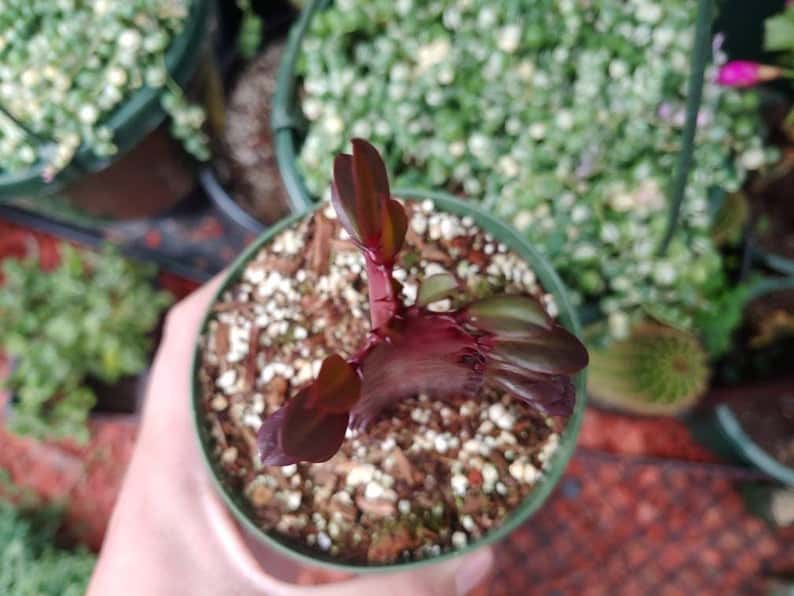
Euphorbia Trigona Repotting Instructions
Repotting your African milk tree is necessary for keeping it healthy. This plant is a heavy feeder, so it won’t be long before the soil or potting mix you used in its pot gets depleted of nutrients. If you are looking for a bigger or new pot, always choose a terracotta pot that is a few inches wider than the one you have now. Your Euphorbia Trigona will not grow well if you put it in a much larger pot.
Fill the new pot with new potting soil. Transplant your African milk tree into the new pot and then ignore it for a few weeks before you water and feed it again.
Where to Buy Euphorbia Trigona Seeds Online
While seeds for this plant are hard to come by, some online retailers do offer them. You should know, however, that these seeds can be out of stock. Check out B and T World Seeds and asked to be notified when these seeds become available.
Alternatively, you can search on Amazon to find the seeds you like, such as this listing.
Where to Buy Euphorbia Trigona Plants Online
If you’re not that eager to start your Euphorbia Trigona from seeds, you can get cuttings from online sellers. Having the plant shipped to you will save you the time you need to wait while the seeds germinate and grow. You can check around eBay, Etsy, or Succulents Box to find the perfect plant for you.
FAQs
Question: It certainly looks like a cactus, but why isn’t the African milk tree classified as a cactus?
Answer: We agree that this plant does look like a cactus. Some people even call it the African milk cactus. But the reason for this is that cacti generally do not have true leaves.
Instead, cacti have spines, which are modified leaves. In contrast, Euphorbia trigona has leaves that grow between the spines that grow at the end of its stems.
And while we’re at it, it’s not a tree either. It’s just that these plants can grow rather tall and can be tree-like in structure.
Question: How fast does Euphorbia Trigona grow?
Answer: Unlike most cacti that are slow-growing and can take 20 years before getting to their full size, the Euphorbia Trigona is moderately fast-growing.
It can start to tower over your garden or yard in just three to five years. It can even grow taller faster if you give it all the things that it needs: well-draining soil, fertilizer, water, and bright but indirect sun.
Question: Tell me more about the Euphorbia Trigona ‘Rubra.’
Answer: If you like the looks of your African milk tree, then you will enjoy the Rubra cultivar. Instead of green, the eaves are colored deep red and magenta.
With green stems, this is one of the most beautiful bi-color succulents you can grow. The Rubra cultivar is very popular among succulent lovers because of its awesome color.
Plus, like the green African milk tree, it’s very easy to care for.
The Euphorbia Trigona: Perfect for Beginners
Euphorbia trigona is probably one of the easiest plants you can grow. Indoors, you just need to make sure that it gets bright indirect light, a weekly watering or less, and well-draining soil.
Grown outside, it’s almost a plant it and forget it affair. You don’t even have to water it as long as it’s not especially dry or hot, it’s not very particular with the soil type, and you don’t have to prune it. Just apply fertilizer now and then. And for very minimal effort, you’re rewarded with a towering succulent that’s sure to attract attention to your garden.

